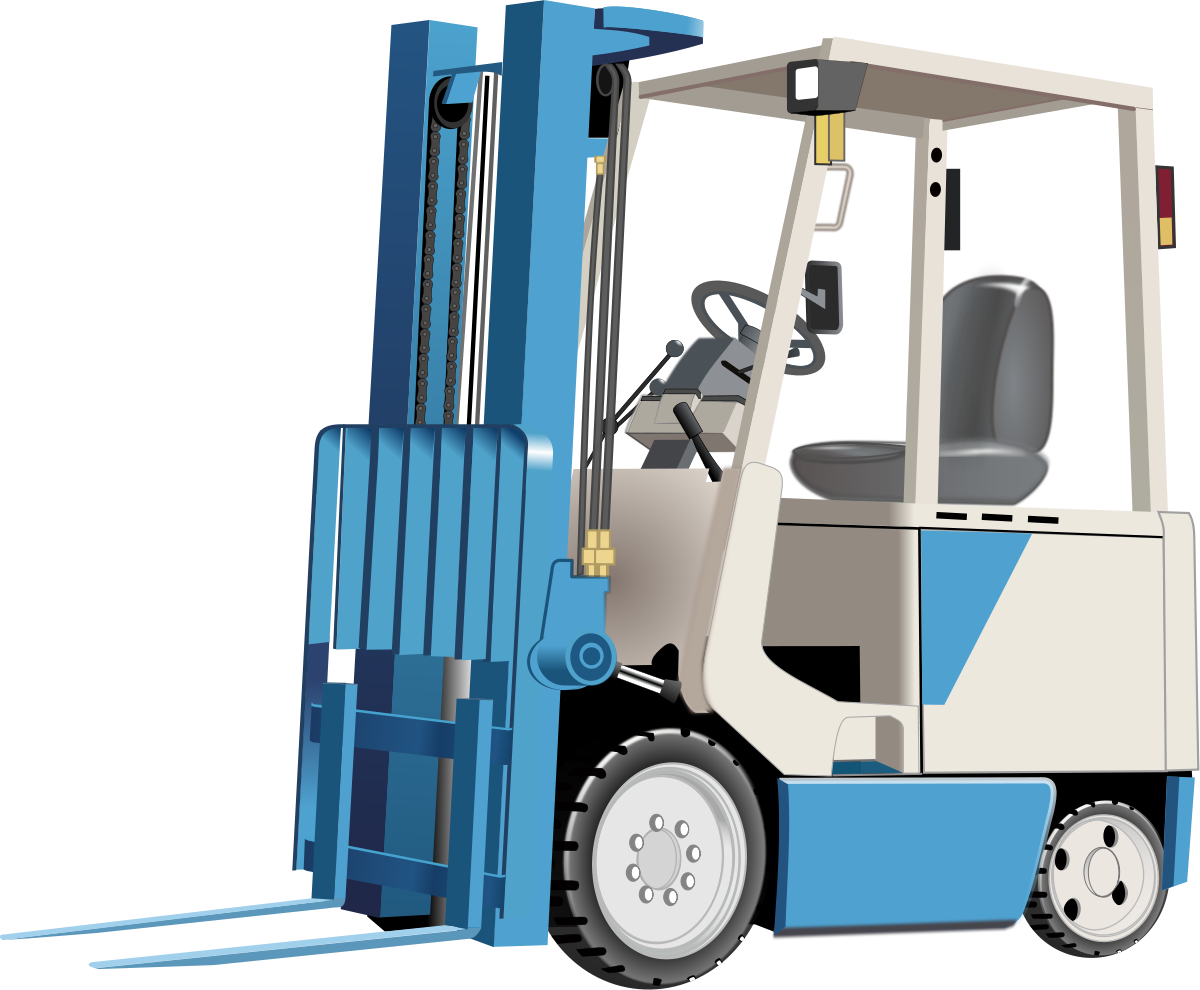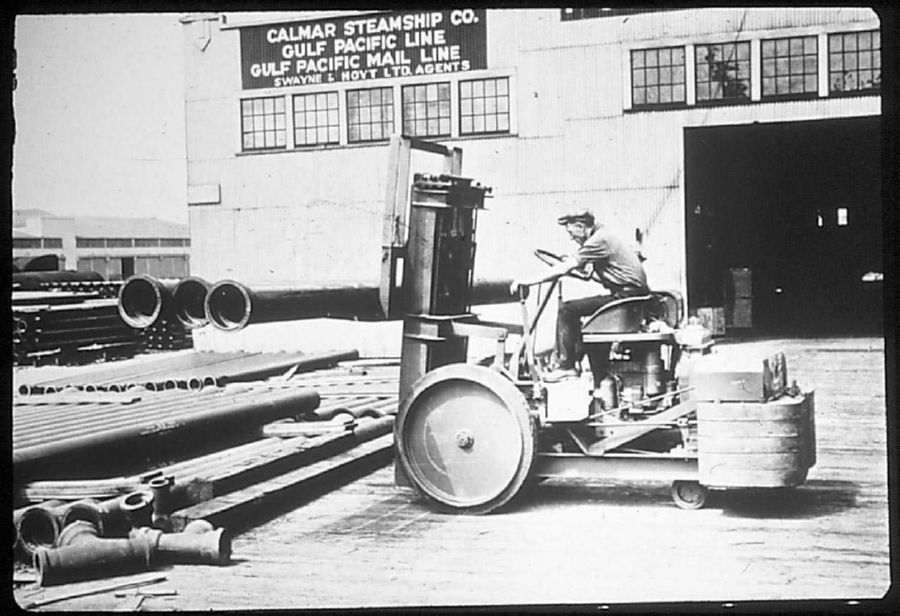Forklift TrucksReading time: 12 min 41 sec. Table of Contents1. Summary2. What is a forklift? 3. History of Forklifts 4. Types of Forklifts 5. Forklift safety 6. Applications of Forklifts 7. Choose Lift Parts Warehouse to buy Forklift Parts 8. Takeaways SummaryThough forklift trucks can lift heavy objects, safety is still a significant issue that should not be taken lightly. There have been reported accidents involving forklift trucks where people got hurt and even died, so proper training is required for forklift operators to properly stack items on a forklift's carriage using a pallet or container without any incidents. Also, forklifts are built in such a way that their weight-handling capability will make the machine tip over if it turns too sharply when its forks are fully loaded with pallets or containers. This means forklift operators must be aware of this "couple" factor before operating forklift trucks to avoid making forklifts lose balance and tip over. More discussed in this article. What is a forklift?A forklift truck is a power-operated vehicle that runs on an electric or gas motor. It can raise and lower things using forks, usually hydraulically powered, mounted to the front for this purpose. They also have wheels to go places that a bigger vehicle themselves may not be able to go. A forklift vehicle is a piece of material handling equipment powered by electricity or hydraulics used to lift and move materials. Forklift vehicle uses include pallet jacks and fork trucks. Forklifts were first designed to carry a load-balanced over the fork - thus their name. Nowadays, forklifts have other attachments such as fork extensions, also known as forks; these allow the lifting and moving of heavy loads that cannot be lifted vertically with the forks alone. Forklifts fork in the same way that scissors cut: having their forkless end meet with an object and then making a forklift-like action. Forks are metal rods connected at their ends to make one long rod, like paperclips bent back on themselves, which is attached to the bottom of the forklift so they can lift forksful of things but not full forklift forks. Forklifting requires enough power to keep somewhere cool or even cold due to all of the electricity used to power it since forklifts exert themselves too much without them and get sweaty armpits and strawberry pickers tongue and breath that smells like forklift fork.
 History of Forklift TrucksThe forklift system was designed in 1917 by the CLARK Equipment Company. It was powered by steam and was used to lift cargo ships' loads of coal for redistribution to railway stations on barges that had previously been manually unloaded. The forklift truck has little changed since its first introduction, with most changes being to the forklift's power source. Forklifts are rated for loads at maximum weights that typically range from 5,000 pounds (2,300 kg) to 34 tons (15 tonnes). Class 8 forklifts—the common classification for the largest industrial forklifts—can exceed 40 tons (18 t). Counterweights used to balance forklift trucks reach up to 70 tons (32 t). The forklift system was originally designed to carry a load-balanced over the fork, thus its name. The forklift truck, in particular, is commonly used to transport pallets and other cargo in warehouses, factories, and freight yards. Forklift systems are powered electrically, hydraulically, by direct engine exhaust, or via gasoline-fueled engines that run on diesel or gasoline. Forklifts are further defined by their weight capabilities in terms of maximum loaded weight capacity and lifting height. The forklift's power source is traditionally electric, hydraulic, compressed air, or an internal combustion engine. Various companies developed the forklift vehicle in the early 1900s, with the most successful and longest-lived of them producing forklifts today. The "claw-of-life" was created when an industrialist witnessed his employees lifting heavy castings by hand using grappling hooks. The first production forklift truck (then called an "automotive forklift") came out of Chicago, Illinois, in 1917, made by the Hough Manufacturing Company (later renamed to Yale & Towne Manufacturing). A forklift is defined by its capacity weight rating and its lift height or fork length. Forks are generally measured in two dimensions: length between the front and back legs; width between tines on the outside of fork ends (fork length). Forks must be long enough to lift the load but not too tall to become unstable. For example, a forklift rated to lift 4,000 pounds or 1.8 tonnes safely has forks of at least 400 mm (16 inches). The forklift operator needs to balance the load, not tilt and become unsafe or difficult to maneuver. Turn radius is another factor in determining forklift suitability: shorter forklifts can turn more sharply than longer ones, but long forklifts can carry greater weight. It was rare for an order picker truck with outriggers and side-shift forks to exceed 16 feet (4.9 m) in length and around 53,000 pounds (23,000 kg) in lift capacity. Many forklift manufacturers are now making much larger forklifts used for special purposes. These forklifts are commonly known as "heavy forklifts" or "exhaust forklifts ."The largest internal combustion forklift trucks typically have a lifting capacity of over 1,000,000 pounds (450 t). Conventional forklifts were previously powered by hydraulics or pneumatics, and electric forklifts became an increasingly popular choice for ergonomic reasons. Electric forklifts have no hydraulic hoses that require insulation and protection from cuts and scrapes. Compared with diesel-engine forklifts, electric models reduce the risk of fire by not having an engine or exhaust near the fork area. Electric forklifts are also much quieter than diesel forklifts, with operating noise in the range of 80-90 dB, akin to a normal conversation between people. These forklifts do not have an engine or exhaust system, so they did not expose their operators or other workers to harmful gases or fumes. The forklift truck was one of the 20th century's greatest engineering achievements and continues to provide around-the-clock lifting power where it is needed most—in warehouses, manufacturing plants, distribution centers, retail supply chains, construction sites, farms, ships, etc.
 Types of Forklift TrucksForklifts are commonly used in warehouses, distribution centers, supermarkets & retail stores to load and unload items. There are different forklifts with varying applications, but the most common forklift is the counterbalanced forklift due to its ease of use and affordable price. If you want to know about forklift pricing, kindly see that blog. The type of forklift is the electric-powered telescopic handler (called a "reach stacker" in some territories). Other types of forklifts include order pickers, tow motors, low-level order pickers, and forklifts. These forklift systems have their purposes, designed specifically for those purposes. Rack forklifts are perfect for moving large amounts of pallets from one location to another because of the way they load onto the fork truck at waist height. Pallet forklifts are used for loading and unloading trucks and stacking materials on top of them. Rough terrain forklifts allow you to easily maneuver through multiple terrains by lifting higher or lower with ease, depending on what is going over. Forklifts, fork trucks, or forklift machines have one or more hydraulic forklift arms used to move material from one location to another. It is also called a pallet truck and fork truck. The forklift's forks are fitted into square holes in the pallets that you want to load and unload. The forklift uses its arms to lift and lower the load through up and down motions on two-directional wheels, usually at the forklift's rear. The forklift has three major parts: mast, fork carriage & fork. Three main types of Forklifts are available: electric forklifts, internal combustion engine forklifts (or IC Engines), and LP gas forklifts. Electric forkliftsElectric forklifts are powered by electricity and can run up to speeds of 18 mph (30 km/h). They have an electric forklift battery, which is used to start the forklift when plugging in is impossible. The forklift uses a DC motor that gets its power from the batteries and then converts it into AC voltage that runs through a controller allowing you to lift and operate your forklift. Internal combustion engine forkliftsInternal combustion engine forklifts use gasoline or diesel as their source of energy. It does not completely stop when unplugged but needs to be plugged in during long breaks or overnight hours because it lacks an electrical system as electric forklifts do. LP gas forkliftsLP gas forklifts, however, consume propane or butane gas, which is filled into the forklift's fuel tank. These forklifts are designed for indoor operation with no harmful fumes and refueled without stopping their engines. It is used where quiet operations are needed, such as libraries, offices, and food services. All forklifts have hydraulic systems that act as a brake; it is responsible for slowing down the forklift when you let go of the controls' joystick. The forklift uses this hydraulic system to raise and lower its forks by pumping fluid (often called hydraulic fluid) through valves enabling the fork to move up and down. Forklifts also use hydraulics to lift loads because their forks are raised using this same principle. Some forklifts are powered by battery, hydraulics, diesel & gasoline. The most common forklift trucks include scissor lift, counterbalanced truck/reach, mast lift, narrow aisle forklift, order picker forklift & pallet stacker forklift. Scissor liftsScissor lift forklifts have a stable base and small height. This forklift vehicle type is mainly used to load and unload shipping containers as it has a wide wheelbase that can push through pallets or containers that are loaded into position. It is also best to use in areas with low clearance. Counterbalanced forkliftsCounterbalanced forklifts have a much longer wheelbase than scissor forklifts but do not require extra space to raise the mast because its design enables it to reach further down. The counterbalanced forklift can also make very steep lifts because of its wheelbase, extending the fork further from its mast fully. Mast forkliftsMost forklifts have a long mast to reach over high stacks of pallets or containers. It can lift more weight than a counterbalanced forklift, but it is harder to operate in tight areas because the fork carriage must be raised before moving forward. Narrow aisle forkliftA narrow aisle forklift is best for warehouses with narrow aisles and requires less clearance than other forklift types, so it has a limited turning radius. The forklift has an under-the-nose design that enables it to park next to obstacles such as racks, columns, and walls, making this type of forklift vehicle perfect for supermarkets, retail stores, and shops. Order picker forkliftAn order picker forklift is commonly used in warehouses and distribution centers because it is designed to lift & carry goods. This forklift type has a telescoping fork carriage that can lower down to the ground to transport pallets on its forks throughout the warehouse or store. Pallet stackers forkliftsPallet stackers forklifts are very similar to order picker forklifts, but instead of having a fork carriage, these forklifts have a mast that holds up a platform where you load items. The forklift's mast then moves up and down as needed for picking more items from storage or stacking them back. It is best not to use pallet stackers lift for heavy lifting such as forklifts with forklifts because the forklift's mast cannot be raised very high. Forklift safetyTo ensure forklift safety, operators must follow several guidelines.
Applications of Forklift TrucksForklift systems are used all over the world in many different industries. They are especially helpful when moving heavy objects from one place to another, and forklift driving is a difficult skill that takes a long time to master. These forklifts can come in many sizes and types, including rack forklifts, pallet forklifts, rough terrain, etc. Forklifts can be found around construction sites and inside warehouses and other large buildings like supermarkets, where they're forkfuls of boxes and other materials from the floor up onto a conveyor or into a forklift's fork. They can also carry pallets that are forkfuls of several boxes or fork fulls of bags filled with things such as drinking straws or chips. The forklift itself may be forked for this purpose, or it may have a forklift-like function so it can lift forkfuls from the floor up to the level of another forklift's forks. Most forklifts have metal feet called forks which allow them to move heavy objects around. The forkless forklifts are called pallet forklifts, and they only have forks on the front but not on the back. To forklift something is to lift it with a forklift or forkless forklift. Forklifts usually come in two colors: red and blue. They're often used for moving heavy objects around, such as boxes, pallets full of forkfuls of bagged things like straws and chips, and forks that need to be moved quickly from one location to another, so their condition doesn't get worse. Construction workers use forklifts, so they don't have to exert too much when moving big things around. A red forklift can carry an object up onto a conveyor belt through its fork, and then the fork is forkful of loading it onto a truck to go somewhere else.
Electric forklifts are perfect indoors, while forklift engines can be used inside or outside the factories. Forklift batteries are best for indoor use, but forklifts with LP gas tanks can also work in enclosed spaces because it does not produce any harmful fumes. Because LP forklift is not recommended to run on public roads, internal combustion engine forklifts are usually used outdoors. In contrast, electric forklifts cannot be driven on dirt and gravel surfaces, so yard trucks (or compact utility vehicles) can choose such areas. Choose Lift Parts Warehouse to buy Forklift PartsIf you are looking for Forklift Parts, look no further as Lift Parts Warehouse is the solution. Lift Parts Warehouse is a website that brings together many of the largest and best Lift Parts Manufacturers in one convenient store. This store offers Lift Truck Spare Parts, Forklift Parts, and other equipment at incredibly low prices; we also promise to bring exceptional customer service and delivery times. Takeaways
|

First Order Special
GET 5% OFF
On Your First Purchase!
Use this discount code
5PERCENTOFF
note: One redemption per account/IP address only

